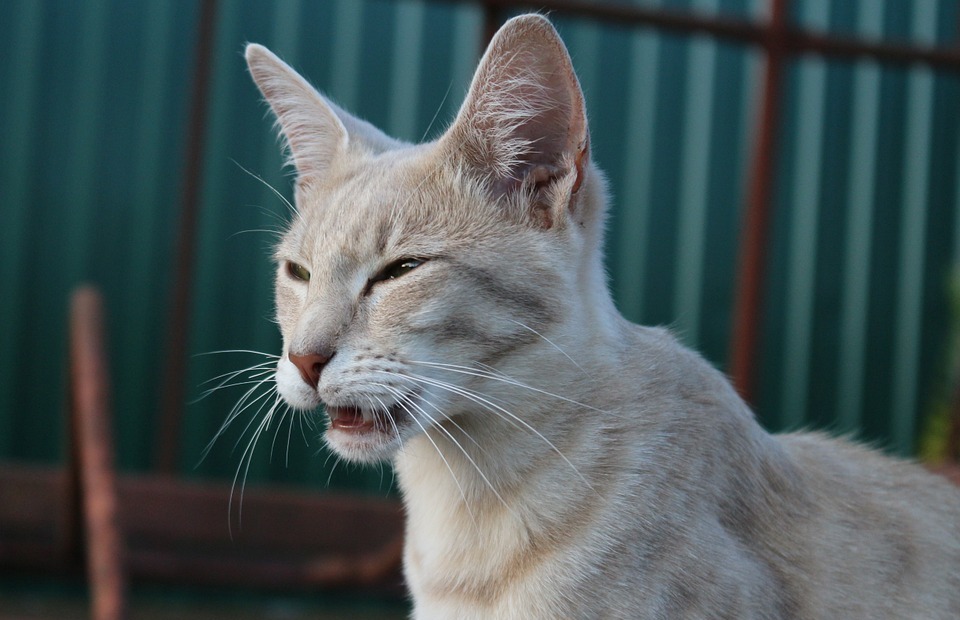Part 1: Demystifying Cat Urine Spraying

1.1 The Spraying Phenomenon:
Cat urine spraying is a distinct behavioural act involving a cat standing with its tail raised, aiming a forceful stream of urine onto vertical surfaces. This behaviour is a form of scent communication, often mistaken for simple accidents. Unlike urination, which is typically aimed at horizontal surfaces, spraying is deliberate and targeted, carrying specific messages within the feline world.1.2 The Difference Between Spraying and Accidents:
- Spraying: A deliberate, forceful expulsion of urine onto vertical surfaces, often accompanied by a characteristic "spraying" posture. This behaviour is driven by instinctual communication and territorial marking.
- Accidents: Unintentional urination, often occurring on horizontal surfaces, typically related to medical issues, stress, or lack of access to a suitable litter box.
1.3 Why Cats Spray: Unveiling the Reasons:
To effectively address spraying behaviour, it's crucial to understand the underlying reasons. Common triggers include:- Territorial Marking: Cats utilize urine spraying to mark their territory, particularly in multi-cat households or when facing a perceived threat.
- Stress and Anxiety: Changes in environment, new pets, loud noises, or even a new piece of furniture can induce stress and anxiety, leading to spraying.
- Medical Conditions: Urinary tract infections (UTIs), bladder stones, and other health issues can cause increased urination, including spraying.
- Hormonal Imbalances: Intact male cats are more prone to spraying due to testosterone levels, while unspayed females may spray during their heat cycles.
- Inappropriate Litter Box: A dirty, inaccessible, or unsuitable litter box can encourage a cat to seek alternative locations, leading to spraying.
Part 2: The Role of Territoriality

2.1 Scent Communication: The Language of Urine:
Cats possess scent glands on their paws, cheeks, and flanks, releasing pheromones that mark their territory. Urine is a potent form of scent communication, conveying information about individual identity, social status, and territorial boundaries.2.2 Multi-Cat Households: Managing Territorial Conflicts:
Introducing a new cat into an established household can trigger territorial conflicts, leading to increased spraying. To prevent this, gradual introductions, scent familiarisation, and providing ample vertical space and resources can help maintain harmony.2.3 New Surroundings: Marking a New Territory:
Moving to a new home or even rearranging furniture can create a sense of insecurity, prompting a cat to re-establish its territory through spraying.Part 3: The Impact of Stress and Anxiety
3.1 Stressors and Triggers:
Environmental changes, new pets or people, loud noises, travel, and even changes in routine can induce stress and anxiety in cats, triggering spraying as a coping mechanism.3.2 Understanding Feline Stress:
Cats are sensitive creatures with complex communication cues. Stress signals can include flattened ears, dilated pupils, hissing, growling, hiding, and avoidance.3.3 Managing Stress and Anxiety:
Providing a safe and secure environment, establishing a consistent routine, and offering calming aids like Feliway can reduce stress and anxiety.Part 4: The Medical Factors
4.1 Urinary Tract Infections (UTIs):
UTIs are a common cause of increased urination in cats, which can manifest as spraying. Symptoms include frequent urination, straining to urinate, blood in the urine, and licking the genital area.4.2 Bladder Stones:
Stones in the bladder can cause pain and discomfort, leading to frequent urination and potential spraying. Cats with bladder stones may exhibit straining, blood in the urine, and a hunched posture.4.3 Other Medical Conditions:
Diabetes, hyperthyroidism, and other medical conditions can cause increased thirst and urination, potentially leading to spraying. A veterinarian can diagnose and treat these conditions.Part 5: Hormonal Factors
5.1 Intact Male Cats:
Unneutered male cats are more prone to spraying due to testosterone levels, which stimulate marking behaviour. Neutering significantly reduces spraying in most cases.5.2 Unspayed Female Cats:
Female cats in heat may spray to attract mates, especially before and during their estrus cycle. Spaying eliminates these hormonal fluctuations and reduces spraying.Part 6: Litter Box Management
6.1 The Importance of Litter Box Cleanliness:
Cats are meticulous creatures and prefer clean litter boxes. Failure to maintain cleanliness can discourage use and encourage spraying as a less desirable alternative.6.2 Access and Location:
Ensure the litter box is easily accessible, in a quiet and private location, away from food and water bowls.6.3 Suitable Litter:
Experiment with different litter types to find one that your cat prefers. Avoid strong scents or textures that might be off-putting.Part 7: Solving the Spraying Problem
7.1 Addressing Medical Causes:
A veterinary examination is crucial to rule out any underlying medical conditions. Treatment for medical issues may involve medications, dietary changes, or surgery.7.2 Environmental Enrichment:
- Multiple Litter Boxes: Provide at least one more litter box than the number of cats in your household to increase accessibility.
- Clean and Accessible Litter Boxes: Scoop regularly and change litter frequently to maintain cleanliness and appeal.
- Suitable Litter: Experiment with different litter types to find your cat's preference.
- Placement: Locate litter boxes in quiet and easily accessible areas, away from food and water bowls.
- Vertical Space: Cats enjoy climbing and exploring. Provide scratching posts, cat trees, and shelves to allow them to access high places.
- Play and Stimulation: Engage your cat in interactive play sessions to provide mental and physical stimulation, reducing boredom and stress.
- Hiding Places: Offer your cat safe and quiet hiding places, such as cardboard boxes, cat beds, or tunnels, where they can retreat when feeling overwhelmed.
7.3 Stress Reduction Techniques:
- Feliway: A synthetic pheromone spray or diffuser that mimics a cat's calming pheromones, reducing stress and anxiety.
- Lavender Oil: A natural calming agent, lavender oil can be diffused or used in a spray to create a relaxing atmosphere.
- Classical Music: Playing classical music can have a calming effect on cats.
- Consistent Routine: Establish a regular feeding, playtime, and grooming routine to provide a sense of security and predictability.
- Positive Reinforcement: Reward your cat with praise, treats, or toys for good behaviour, such as using the litter box.
7.4 Professional Help:
- Veterinarian: A veterinarian can provide medical diagnosis and treatment, as well as guidance on behavioural modification strategies.
- Certified Animal Behaviourist: A certified animal behaviourist can offer specialized advice and training tailored to your cat's specific needs.
Part 8: Cleaning Up Urine Stains and Odours
8.1 Removing Urine Stains:
- Enzyme-Based Cleaners: Use commercial enzyme-based cleaners specifically designed to break down urine molecules and eliminate odours.
- Baking Soda: Sprinkle baking soda liberally on the affected area, leave it for several hours, and then vacuum thoroughly.
- White Vinegar: Mix equal parts white vinegar and water in a spray bottle. Spray the affected area and blot with a clean cloth.
8.2 Eliminating Urine Odours:
- Odour-Neutralising Products: Use odour-neutralising sprays or solutions specifically designed to eliminate pet urine odours.
- Activated Charcoal: Place bowls of activated charcoal around the affected area to absorb odours.
- Black Tea: Brew strong black tea and allow it to cool. Apply the tea to the affected area using a spray bottle or cloth.
Part 9: Preventing Future Spraying
9.1 Ongoing Maintenance:
- Regular Litter Box Cleaning: Maintain a clean and appealing litter box environment to encourage its use.
- Environmental Enrichment: Continue providing ample play, stimulation, and hiding places to reduce stress and boredom.
- Feliway Usage: Continue using Feliway diffuser or spray to maintain a calming atmosphere.
9.2 Managing Stress:
- Identify Stress Triggers: Pay attention to any environmental changes or events that might trigger your cat's anxiety.
- Minimise Stressors: Reduce or eliminate any potential stressors whenever possible.
- Provide Security: Create a safe and secure environment for your cat, with plenty of hiding places and familiar routines.
Part 10: FAQs
Q1: My cat has started spraying suddenly. What should I do?
A sudden onset of spraying can indicate a medical problem, such as a UTI or bladder stones. It's essential to consult your veterinarian for an examination and possible treatment. Once any medical issues are ruled out, you can address potential stress triggers and environmental factors.
Q2: Is it normal for cats to spray?
Spraying is a natural behaviour for cats, particularly unneutered or unspayed cats. However, excessive or inappropriate spraying can indicate stress, anxiety, or medical problems. It's important to address the cause of spraying to prevent it from becoming a persistent issue.
Q3: How do I stop my cat from spraying on my furniture?
Firstly, address any potential medical reasons and provide a clean and accessible litter box. Then, you can deter your cat from spraying on furniture by using deterrent products like commercial cat deterrents or citrus peels. You can also cover furniture with fabric protectors or covers to make it less appealing.
Q4: Can I use a water bottle to stop my cat from spraying?
While spraying your cat with water may temporarily deter the behaviour, it's not a long-term solution. It can also create fear and anxiety, making the situation worse. Focus on addressing the underlying cause and providing positive reinforcement.
Q5: What if my cat is spraying outside the litter box?
If your cat is spraying outside the litter box, you need to address the potential causes: medical issues, unsuitable litter box conditions, stress, or territorial marking. Once you've identified the root cause, you can implement appropriate solutions to stop the behaviour.
Q6: Should I punish my cat for spraying?
Punishing your cat for spraying is counterproductive. It can create fear and anxiety, making the problem worse. Instead, focus on addressing the underlying cause and providing positive reinforcement for using the litter box.
Q7: How long does it take to stop a cat from spraying?
The time it takes to stop a cat from spraying varies depending on the underlying cause and the effectiveness of the implemented solutions. It's important to be patient and persistent, as it may take several weeks or months to see improvement.
Q8: Can I use a commercial cat spray to stop the spraying?
Commercial cat sprays often contain citrus or other scents that cats find aversive. While they can deter spraying temporarily, they may not address the underlying cause. Use them cautiously, as some cats are sensitive to strong scents.
Q9: What if my cat is spraying in multiple locations?
If your cat is spraying in multiple locations, it indicates a more severe issue, possibly a combination of factors. Consult your veterinarian or a certified animal behaviourist for a comprehensive evaluation and personalized advice.
Everyone is watching

Are Cat Ribs Flexible? Understanding Their Anatomy
CATS & KITTENSThis article delves into the fascinating world of feline anatomy, exploring the flexibility of cat ribs and ho...

Can Cats Eat Bananas? (Everything You Need to Know)
CATS & KITTENSThis article dives into the intriguing question of whether cats can safely enjoy the sweet, yellow fruit, bana...

Cat Lifespan: How Long Do Cats Live?
CATS & KITTENSThis comprehensive guide explores the factors influencing the lifespan of our feline companions, providing ins...

Can Cats Get COVID-19? What You Need to Know
CATS & KITTENSThis article will delve into the fascinating world of feline COVID-19 susceptibility. We'll explore whether ca...

Can Cats Eat Eggs? A Complete Guide to Egg Safety for Your Feline Friend
CATS & KITTENSWhen it comes to treating our furry companions, we all want to ensure we're doing what's best for them. Eggs...
